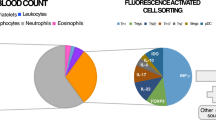Abstract
The etiology and pathogenesis of primary achalasia are both unknown. Postulated mechanisms include autoimmune, viral-immune, and central neurodegenerative. The aim of this study is to investigate the serum profile of neural autoantibodies in patients with primary achalasia. Coded sera from 70 patients with primary achalasia and 161 healthy control subjects, matched in sex, age, and smoking habits, were screened for antibodies targeting neuronal, glial, and muscle autoantigens. No specific myenteric neuronal antibody was identified. However, the overall prevalence of neural autoantibodies in patients with primary achalasia was significantly higher than in healthy control subjects (25.7 vs. 4.4%, P < 0.0001). Most noteworthy was the 21.4% frequency of glutamic acid decarboxylase-65 antibody in patients with achalasia (versus 2.5% in control subjects), in the absence of diabetes or companion antibodies predictive of type 1 diabetes. This profile of autoantibodies suggests an autoimmune basis for a subset of primary achalasia.
Similar content being viewed by others
References
Willis T. Pharmaceutice rationalis: Sive diatribe de medicamentorum; operationibus in humano corpore. Long, Hague-Comitis 1674:18–19.
Kraichely RD, Farrugia G. Achalasia: physiology and etiopathogenesis. Dis Esophagus. 2006;19:213–223. doi:10.1111/j.1442-2050.2006.00569.x.
Agrawal A, Hila A, Tutuian R, Castell DO. Manometry and impedance characteristics of achalasia. Facts and myths. J Clin Gastroenterol. 2008;42:266–270. doi:10.1097/MCG.0b013e31815f8e17.
Goldblum JR, Rice TW, Richter JE. Histopathologic features in esophagomyotomy specimens from patients with achalasia. Gastroenterology. 1996;111:648–654. doi:10.1053/gast.1996.v111.pm8780569.
Holloway RH, Dodds WJ, Helm JF, Hogan WJ, Dent J, Arndorfer RC. Integrity of cholinergic innervation to the lower esophageal sphincter in achalasia. Gastroenterology. 1986;90:924–929.
Verne GN, Hahn AB, Pineau BC, Hoffman BJ, Wojciechowski BW, Wu W. Association of HLA-DR and -DQ alleles with idiopathic achalasia. Gastroenterology. 1999;117:26–31. doi:10.1016/S0016-5085(99)70546-9.
Clark SB, Rice TW, Tubbs RR, Richter JE, Goldblum JR. The nature of the myenteric infiltrate in achalasia: an immunohistochemical analysis. Am J Surg Pathol. 2000;24:1153–1158. doi:10.1097/00000478-200008000-00014.
Ruiz-de-León A, Mendoza J, Sevilla-Mantilla C, et al. Myenteric antiplexus antibodies and class II HLA in achalasia. Dig Dis Sci. 2002;47:15–19. doi:10.1023/A:1013242831900.
Altermatt HJ, Williams CL, Lennon VA. Paraneoplastic cerebellar autoantibodies associated with gynecological cancer bind to myenteric plexus neurons. Ann Neurol. 1991;29:687–688. doi:10.1002/ana.410290621.
Lennon VA, Sas DF, Busk MF, et al. Enteric neuronal autoantibodies in pseudoobstruction with small-cell lung carcinoma. Gastroenterology. 1991;100:137–142.
Lucchinetti CF, Kimmel DW, Lennon VA. Paraneoplastic and oncologic profiles of patients seropositive for type 1 anti-neuronal nuclear autoantibodies. Neurology. 1998;50:652–657.
Smith VV, Gregson N, Foggensteiner L, Neale G, Milla PJ. Acquired intestinal aganglionosis and circulating autoantibodies without neoplasia or other neural involvement. Gastroenterology. 1997;112:1366–1371. doi:10.1016/S0016-5085(97)70151-3.
Yu Z, Kryzer TJ, Griesmann GE, Kim K, Benarroch EE, Lennon VA. CRMP-5 neuronal autoantibody: marker of lung cancer and thymoma-related autoimmunity. Ann Neurol. 2001;49:146–154. doi:10.1002/1531-8249(20010201)49:2<146::AID-ANA34>3.0.CO;2-E.
Dhamija R, Tan KM, Pittock SJ, Foxx-Orenstein A, Benarroch E. Lennon VA: serological profiles aiding the diagnosis of autoimmune gastrointestinal dysmotility. Clin Gastroenterol Hepatol. 2008;6:988–992. doi:10.1016/j.cgh.2008.04.009.
Pasha SF, Lunsford TN, Lennon VA. Autoimmune gastrointestinal dysmotility treated successfully with pyridostigmine. Gastroenterology. 2006;131:1592–1596. doi:10.1053/j.gastro.2006.06.018.
Vernino S, Low PA, Fealey RD, Stewart JD, Farrugia G, Lennon VA. Autoantibodies to ganglionic acetylcholine receptors in autoimmune autonomic neuropathies. N Engl J Med. 2000;343:847–855. doi:10.1056/NEJM200009213431204.
Griesmann GE, Kryzer TJ, Lennon VA. Autoantibody profiles of myasthenia gravis and Lambert-Eaton myasthenic syndrome. In: Rose NR, Hamilton RG, Detrick B, eds. Manual of clinical and laboratory immunology. Washington, DC: ASM Press; 2002:1005–1012.
Pittock SJ, Kryzer TJ, Lennon VA. Paraneoplastic antibodies coexist and predict cancer, not neurological syndrome. Ann Neurol. 2004;56:715–719. doi:10.1002/ana.20269.
Pittock SJ, Yoshikawa H, Ahlskog JE, et al. Glutamic acid decarboxylase autoimmunity with brainstem, extrapyramidal and spinal cord dysfunction. Mayo Clin Proc. 2006;81:1207–1214. doi:10.4065/81.9.1207.
Vernino S, Lennon VA. Autoantibody profiles and neurological correlations of thymoma. Clin Cancer Res. 2004;10:7270–7275. doi:10.1158/1078-0432.CCR-04-0735.
Wenzlau JM, Juhl K, Yu L, et al. The cation efflux transporter ZnT8 (Slc30A8) is a major autoantigen in human type 1 diabetes. Proc Natl Acad Sci USA. 2007;104:17040–17045. doi:10.1073/pnas.0705894104.
Verne GN, Sallustio JE, Eaker EY. Anti-myenteric neuronal antibodies in patients with achalasia. A prospective study. Dig Dis Sci. 1997;42:307–313. doi:10.1023/A:1018857617115.
Reis HJ, Vanden Berghe P, Romano-Silva MA, Smith TK. GABA-induced calcium signaling in cultured enteric neurons is reinforced by activation of cholinergic pathways. Neuroscience. 2006;139:485–494. doi:10.1016/j.neuroscience.2005.12.023.
O’Suilleabhain P, Low P, Lennon VA. Autonomic dysfunction in the Lambert-Eaton myasthenic syndrome: serologic and clinical correlates. Neurology. 1998;50:88–93.
Alagozlu H, Unal S, Karadan T, Cindoruk M, Ergun M. Small-volume gallbladders and decreased motility in patients with achalasia. J Clin Gastroenterol. 2008;42:191–193. doi:10.1097/01.mcg.0000225682.52712.f7.
Simpson JA. Myasthenia gravis: a new hypothesis. Scott Med J. 1960;5:419–436.
Lennon VA, Lambert EH, Wittingham S, Fairbanks V. Autoimmunity in the Lambert-Eaton myasthenic syndrome. Muscle Nerve. 1982;5:S21–S25.
Lennon VA, Lambert EH. Myasthenia gravis induced by monoclonal antibodies to acetylcholine receptors. Nature. 1980;285:238–240. doi:10.1038/285238a0.
Lennon VA, Kryzer TJ, Griesmann GE, et al. Calcium-channel antibodies in the Lambert-Eaton syndrome and other paraneoplastic syndromes. N Engl J Med. 1995;332:1467–1474. doi:10.1056/NEJM199506013322203.
Acknowledgments
We thank Carissa Dege and Sue Nodtvedt for excellent technical assistance. This work was supported by grants from the National Institutes of Health DK068055, DK 71209, DK52766, DK57061, and DK65154.
Author information
Authors and Affiliations
Corresponding author
Rights and permissions
About this article
Cite this article
Kraichely, R.E., Farrugia, G., Pittock, S.J. et al. Neural Autoantibody Profile of Primary Achalasia. Dig Dis Sci 55, 307–311 (2010). https://doi.org/10.1007/s10620-009-0838-9
Received:
Accepted:
Published:
Issue Date:
DOI: https://doi.org/10.1007/s10620-009-0838-9




